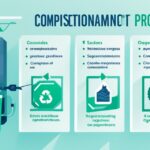Ensuring Continuity: The Importance of Workstation Recovery
In today’s dynamic business landscape, the continuity of operations and the ability to navigate disruptions are crucial for long-term success. Business Continuity (BC) and Disaster Recovery (DR) have emerged as vital pillars in safeguarding critical business functions during unexpected events. BC focuses on proactive measures to identify vulnerabilities and implement strategies to mitigate disruptions, while DR is concerned with restoring essential technological systems and infrastructures after a catastrophe. These disciplines are essential for businesses of all sizes in the UK, ensuring adaptability, responsiveness, and the safety of operations.
Key Topics for Implementing Business Continuity and Disaster Recovery
Implementing BC and DR requires addressing key topics to enhance resilience, maintain stability, and minimize the impact of disruptions on critical business operations. To ensure a comprehensive BC and DR strategy, organizations should focus on the following:
Risk Assessment and Analysis
Identifying potential risks and evaluating their likelihood and impact is the first step in developing an effective BC and DR plan. A thorough risk assessment enables organizations to prioritize their efforts and allocate resources accordingly.
Business Impact Analysis (BIA)
Conducting a BIA helps organizations understand the potential consequences of disruptions on critical business functions. By identifying the dependencies and interdependencies between processes, systems, and resources, organizations can develop strategies to minimize the impact of disruptions.
Developing Continuity and Recovery Strategies
Based on the results of the risk assessment and BIA, organizations should develop continuity and recovery strategies that outline specific actions to be taken in the event of a disruption. These strategies should consider both proactive measures to prevent disruptions and reactive measures to restore operations swiftly.
Plan Implementation and Activation
Developed plans must be implemented and regularly updated to ensure their effectiveness. Organizations should define clear activation criteria and establish communication channels, roles, and responsibilities to facilitate a coordinated response in the event of a crisis.
Emergency Response and Incident Management
Having a well-defined emergency response plan and incident management protocols is essential for efficient crisis response. Organizations should establish clear procedures for assessing and escalating incidents, coordinating resources, and communicating with stakeholders.
Communication and Stakeholder Management
Effective communication is critical during a crisis. Organizations should develop communication strategies that outline how and when to communicate with internal and external stakeholders, ensuring transparency, clarity, and consistency of messages.
Testing, Exercising, and Maintenance
Regular testing and exercising of BC and DR plans is vital to ensure their readiness and identify areas for improvement. Organizations should conduct tabletop exercises, simulations, and real-time drills to evaluate the effectiveness of their plans and update them accordingly.
Continuous Improvement and Lessons Learned
A culture of continuous improvement allows organizations to learn from past incidents and make necessary adjustments to their BC and DR strategies. After every disruption, organizations should conduct thorough reviews, identify lessons learned, and implement changes to enhance future response capabilities.
Legal and Regulatory Compliance
Organizations must ensure that their BC and DR plans comply with relevant legal and regulatory requirements. This includes data protection regulations, industry-specific regulations, and any other applicable laws and standards.
Resource Allocation and Budgeting
Allocating adequate resources, both financial and human, is crucial for successful BC and DR implementation. Organizations should consider the costs associated with risk mitigation, plan development, technology investments, training, and ongoing maintenance.
Business Continuity Governance and Leadership
Establishing clear governance structures and assigning leadership roles is essential for the effective execution of BC and DR strategies. Organizations should designate individuals or teams responsible for championing and overseeing the BC and DR efforts, ensuring accountability and alignment with organizational objectives.
When addressing these key topics, organizations can develop robust BC and DR strategies that protect critical business functions and enhance the overall resilience of their operations. By taking a proactive approach to risk management, organizations can minimize the impact of disruptions, ensure business continuity, and safeguard their reputation.
Benefits of Implementing Business Continuity and Disaster Recovery
Implementing business continuity (BC) and disaster recovery (DR) planning offers numerous benefits for organizations in the UK. These strategies enhance operational resilience, minimize downtime and financial losses, protect reputation, ensure regulatory compliance, safeguard data and information security, optimize resource allocation, and provide a competitive advantage. Let’s explore each of these benefits in more detail:
1. Operational Resilience
Implementing BC and DR planning allows businesses to adapt and continue critical operations during disruptions, ensuring operational stability and minimizing the impact of unforeseen events. By proactively identifying vulnerabilities and implementing strategies to mitigate them, organizations can remain resilient and agile in the face of challenges.
2. Minimized Downtime and Financial Losses
BC and DR strategies enable organizations to quickly recover from disruptions, minimizing downtime and associated financial losses. By having robust plans and mechanisms in place to restore operations efficiently, business interruptions can be minimized, ensuring continuity and preserving revenue streams.
3. Reputation Protection
By demonstrating responsiveness to clients, customers, and stakeholders during times of crisis, businesses can protect their reputation. Effective BC and DR planning ensures swift recovery and continuity, showcasing a commitment to the well-being and satisfaction of customers, which builds trust and loyalty.
4. Regulatory Compliance
Compliance with legal and regulatory requirements is essential for organizations across industries. BC and DR strategies help businesses meet these obligations, ensuring continuity of operations, safeguarding sensitive data, and protecting the interests of stakeholders.
5. Data and Information Security
Data breaches and cyber threats pose significant risks to organizations. BC and DR planning include measures to protect data and information security, implementing robust security protocols and safeguards, minimizing vulnerabilities, and ensuring business continuity in the event of a security incident.
6. Resource Optimization
Efficient allocation of resources is crucial for the success of any organization. BC and DR strategies enable businesses to optimize resource allocation by identifying critical functions, prioritizing recovery efforts, and ensuring the availability of necessary resources during disruptions. This streamlined approach helps contain costs and promotes operational efficiency.
7. Competitive Advantage
Organizations that prioritize BC and DR gain a competitive edge. By demonstrating the ability to respond effectively to disruptions and maintain continuity, businesses can attract and retain clients and customers who value stability and reliability. This advantage strengthens the organization’s position in the market and sets it apart from competitors.
8. Facilitating Quick Recovery
BC and DR planning streamline the recovery process, enabling organizations to bounce back swiftly from adverse events. With predefined procedures and protocols in place, businesses can minimize the time and effort required to restore critical operations, ensuring minimal disruption to productivity.
9. Stakeholder Confidence
Effective BC and DR strategies instill confidence in employees, customers, investors, and other stakeholders. Knowing that the organization has robust plans to navigate disruptions and protect continuity fosters trust, enhances loyalty, and strengthens relationships, leading to long-term success and growth.
| Benefit | Description |
|---|---|
| Operational Resilience | Allows businesses to adapt and continue critical operations during disruptions. |
| Minimized Downtime and Financial Losses | Enables quick recovery, minimizing downtime and associated financial losses. |
| Reputation Protection | Demonstrates responsiveness, preserving reputation and building trust. |
| Regulatory Compliance | Ensures compliance with legal and regulatory requirements. |
| Data and Information Security | Protects sensitive data and information from breaches and cyber threats. |
| Resource Optimization | Optimizes resource allocation, containing costs and promoting efficiency. |
| Competitive Advantage | Sets the organization apart from competitors, attracting and retaining clients. |
| Facilitating Quick Recovery | Speeds up the recovery process, minimizing disruption to productivity. |
| Stakeholder Confidence | Instills confidence in employees, customers, and other stakeholders. |
Introduction to Business Continuity and Disaster Recovery (BC & DR)
In today’s volatile business landscape, every organization must be prepared to tackle unexpected disruptions and maintain operational stability. This is where Business Continuity (BC) and Disaster Recovery (DR) come into play. BC focuses on proactive measures and strategic planning to ensure critical business functions continue seamlessly during a disaster. On the other hand, DR comprises the reactive steps taken to restore operations after an incident. Together, BC and DR form an integral part of a holistic approach to organizational success, safeguarding against downtime and minimizing the impact of disruptions on productivity.
While BC encompasses the entire organization and addresses long-term challenges, DR primarily focuses on the technology infrastructure and the necessary steps to resume operations efficiently. Both BC and DR work in tandem, forming a comprehensive strategy that enhances operational stability and resilience.
Key Features of Business Continuity (BC)
BC involves a proactive approach, ensuring that businesses can continue their critical functions during a disaster. Key features of BC include:
- Identifying potential risks and vulnerabilities
- Implementing preventative measures and strategies
- Creating backup plans for key operations
- Establishing communication protocols for stakeholders
- Regularly reviewing and updating BC plans
BC requires a strategic mindset and a thorough understanding of the organization’s operations, allowing businesses to navigate disruptions and maintain stability.
Disaster Recovery (DR): Restoring Operations after an Incident
DR, on the other hand, focuses on reactive measures to resume operations swiftly and efficiently in the aftermath of a disaster. Key features of DR include:
- Evaluating the impact of the disruption
- Restoring critical systems and infrastructure
- Recovering data and information
- Testing and validating the effectiveness of DR plans
- Monitoring and continuously improving DR capabilities
DR places importance on technology infrastructure and data recovery, ensuring that businesses can recover from incidents and resume operations with minimal downtime.
A Holistic Approach to Organizational Stability
By combining BC and DR, organizations can foster operational stability and resilience. BC allows businesses to anticipate and mitigate potential disruptions, while DR ensures rapid recovery and restoration of critical functions. This holistic approach minimizes the impact of unexpected events, maximizes productivity, and safeguards the long-term success of businesses.
Conclusion
Data backup and recovery are essential for ensuring business continuity in the face of unexpected disruptions. By implementing robust data backup and recovery strategies, businesses can mitigate the risk of data loss and safeguard against cyber threats. Additionally, these strategies help organizations ensure regulatory compliance and minimize downtime, allowing them to maintain operational stability.
For businesses in the UK, it is crucial to prioritize data backup and recovery as part of their overall business continuity plan. By doing so, they can protect their valuable data, maintain resilience, and quickly recover from any unforeseen incidents.
Arrow PC Network offers comprehensive data backup and recovery solutions tailored to the specific needs of organizations. Their reliable and proactive approach ensures the safety and availability of critical data, providing peace of mind for businesses in the UK. To fortify your business against data loss and cyber threats, contact Arrow PC Network today.
FAQ
What is the difference between Business Continuity (BC) and Disaster Recovery (DR)?
Business Continuity focuses on proactively identifying vulnerabilities and implementing strategies to mitigate disruptions, while Disaster Recovery is concerned with restoring essential technological systems and infrastructures after a catastrophe.
What are the key topics for implementing Business Continuity and Disaster Recovery?
The key topics include risk assessment and analysis, business impact analysis, developing continuity and recovery strategies, plan implementation and activation, emergency response and incident management, communication and stakeholder management, testing, exercising, and maintenance, continuous improvement and lessons learned, legal and regulatory compliance, resource allocation and budgeting, and business continuity governance and leadership.
What are the benefits of implementing Business Continuity and Disaster Recovery?
Implementing BC and DR enhances operational resilience, minimizes downtime and financial losses, safeguards reputation, ensures regulatory compliance, protects data and information security, optimizes resource allocation, contains costs, boosts employee confidence, ensures customer continuity, provides a competitive advantage, facilitates quick recovery, and instills stakeholder confidence.
How does data backup and recovery contribute to business continuity?
Data backup and recovery mitigate the risk of data loss, safeguard against cyber threats, ensure regulatory compliance, and minimize downtime, thereby ensuring business continuity and maintaining resilience in the face of unexpected disruptions.
What data backup and recovery solutions does Arrow PC Network offer?
Arrow PC Network offers comprehensive data backup and recovery solutions tailored to the specific needs of organizations, ensuring the safety and availability of critical data.















